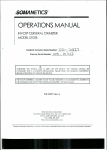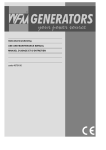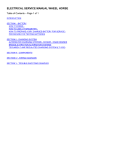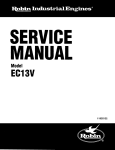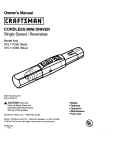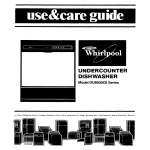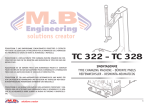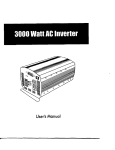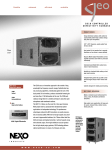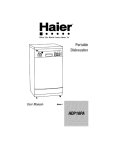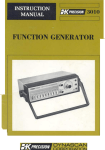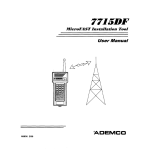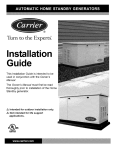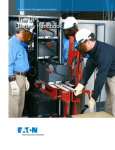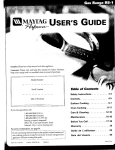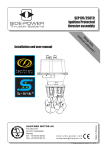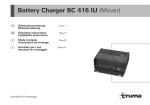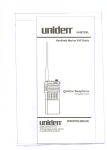Download batteries
Transcript
THEORY OF OPERATION Secondary, orstorage, cells have reversibleactions known as "charge" and "discharge." A storage cell must first be charged by sending a current throughthe an outsidesource. positiveterminalfrom On discharge,currentpasses throughthe cell in an opposite direction. When the cell provides a current, or discharges, it simply reversesthechemicalreactionthattakes place' during the charging period. An elec-* triccurrent(chargecurrent)replacesthe lostchemicalenergybeforethecyclecan s t a r t again. A batteryproducesanelectriccurrent by chemicalaction. A battery consists of one ormoreunitscalled “cells.” Cells may bedividedinto two classes:primary and secondary (storage). Cells used in flashlights, hearing aids, and portableradios areprimary cells.They produce an electric current because of materials used in their construction. When all the chemical energy has been converted into electrical energy, the cell can no longer be used until new materials are added. POSITIVE- PLATE FIGURE 1 in Lawn-Boy Thelead-acidbatteryused 1.) mowersconsists of six cells.(Figure The atoms in the electrolyte are neutral because they have an equal number of positive and negativecharges. When electrolyte is dissolved in water, it splits into positive and negative ions. Positiveionshave a deficiency of electrons.Negativeionshavean excess of electrons. The positiveplate is now attacked by theelectrolyte(sulfuric acid) which picks up someelectrons.The electrolyte acts as a carrier for these electrons to the negative plate and from there through the rest of the circuit. Duringthechargingprocess the chainreaction is reversed and electrons move through the electrolyte to ,the positive plate. NEGATIVE PLATE BATTERY SERVICE BATTERY STRUCTURE COVER PLATE FIGURE The main parts in figure 2. of a battery are illustrated BATTERY The negative plate consists of a grid framework filled with a porous mass of lead. This spongy form of leadallowselectrolyteto penetrate the negative plates freely for the life of the battery. The positive plates are made up of a grid framework which is filled with a lead peroxide material. No positive plate may touch a negative plate o r all platesinthecell will losetheir stored energy. Therefore thin sheets of non- conducting material called separators a r e placed between the plates. The lead and lead peroxide plates are referred to as the "active" materials of the battery. These materials cannot become by a diluted activeuntiltheyarecovered solution of sulfuricacidcalled"electroas a c a r r i e rf o r lyte." Sulfuricacidacts the electric current within the battery. Thebatterycontainer and cover a r e both made of a durable plastic and are inactive to the corrosive electrolyte. Filler plugs a r e designedtobafflegases, prevent loss of acid due to vibration and for filling cells to their proper level. MAINTENANCE CHECKS AND SERVICE Maintenance NOTE Maintenance checks should be made regularly to assure good performance of the battery. Maintenancechecksshouldbemaderegularlytoassure good performance of the battery. 1. Checkfluidlevelineachcell and add mineral free water if necessary. 2. Check terminals for dirt and grease. If dirty or greasy remove cable clamps and clean terminals. 3. Check voltage of battery. If battery is no longerstrong enough to start mower o r it is a hardstartingmower,recharge battery. SERVICE BULLETIN REFERENCES 13-2 REVISED 1977 BATTERY SERVICE 4. To rechargebattery,insert plug into State of ChargeSpecificGravityReading trickle chargerinto charger jack.Plug 1.265 110 volt AC outlet,allowingbatteryto ChargedFully 75% Charged 1.225 charge approximately ten hours. 50% Charged 1.190 25% charged 1.155 Discharged 1.120 NOTE 1. Remove caps from battery using screwdriver. Do not chargeforlongerthan 48 hours, as extended charge times will cause electrolyte to evaporate leaving a dry and damaged battery. Allowbattery to stand for some time after filling before placing on charge 2. Placehydrometer(part no. 681007) (see figure 3) into each cell. Squeeze bulb on top of hydrometer and release slowly. 5. When charging battery use only the LAWN-BOY chargersupplied with the mower. Do not charge at a rate exceeding 1 amp. 3. Number of balls floatingindicatescondition of battery. If any cell reads two ballsor less floating, rechargebattery for 10 hours. Servicing Specific Gravity of Battery When using a hydrometer that showsspecific gravity,thefollowingspecificgravity numbers (when measured at 80°F (26.7°C) indicate the approximate battery charge condition. FIGURE 3 SERVICE BULLETIN REFERENCES 13-3 REVISED 1977 BATTERY SERVICE AGING BATTERIES For accuracy, the liquid level of the cells should be at normal height when a hydrometer reading is taken. Hydrometerreadingsshouldnever be taken immediately after water has been added to battery or immediately after charging. Let stand for 20 minutes. Specific gravity of fully charged battery should be 1.265 with 80°F. (26.7ºC) electrolytetemperature. As batteries age,theyprogressivelylose their ability to reach their rated full charge first involtageandspecificgravity.The dication would be high water usage. 1. When this happens, charging time should be decreased from 10 hours to 8 hours, from 8 hours to 6 hours, etc., until battery's useful life has been spent. 2. When specific gravity readings, taken at one hour intervals, remain the same, the battery has all thecharge it is capable of accepting. SAFETY WARNING Battery electrolyte is an acidic solution and should be handled with care. If electrolyte is spilled or splashed on any part of the body, immediately flush the exposed area with liberal amounts of water and obtainmedical aid as soon as possible. 3. If the level of voltage is too low for normal operation of mower, replace battery. TESTING BATTERY FOR SERVICE,ABILITY INSTRUMENTS Testing a battery for serviceability requires the use of instruments of unquestioned accuracy. BATTERY CORROSION Theoverflow of electrolytecauses many problems. Corrosion begins to form on the battery terminals and in battery box. Corrosion is a good conductor, causing a d r a i n on battery even when mower is notinuse. Corroded batteries, terminals and frames should be cleaned with a solution of four tablespoons of baking sodato a gallon of water. 2. Brush on the soda-water solution with a brushandflushclean with fresh water. 3. Coat terminal connections with petroleum jellyafterreassemblytoretardcorrosion. SAFETY WARNING Do not usepressure gun greases on connections as some contain graphite, which conducts electricity, and others will deteriorate battery sealer. A Hydrometer should be graduated to read from 1.160 to 1.320 ingraduations of ,005 specificgravity.Thegraduatedmarkings should be not less than 1/16'' (1.6 mm) apart and accurate towithin ,002 Sp. Gr.The graduatedportion of thestemshouldbe about 2 inches (50.8 mm) long. Clearance between float and barrel, at smallest diameter,shouldbeminimum a of 1/8 inch (3.2mm) around all sides. A batteryThermometershouldbe of the mercury-in-glass type, have a scale reading as high as' 125°F. (51.6ºC), and be designed (25 mm)bulb imf o r not overa,1-inch mersion. A suitabledairy-typethermome t e r may prove satisfactory for the purpose. Shop electrical meters battery for testing shouldbeaccuratewithin 2 percentover the entire scale range. Laboratory meters should be accurate within 1/2 of 1 percent overtheentirescalerange and shouldbe of the permanent magnet moving coil type, 13-4 SERVICE BULLETIN REFERENCES REVISED 1977 the voltmeter preferably being shieldedfrom external magnetic fields. 3-volt a scale in .02-volt divisions and be accurate towithin 1%over full scale for measuring cell voltageand/orscale a covering15 volts in .l-volt divisions for testing overall battery voltage.The resistance of a good voltmeter is at least 20,000 ohms per volt. A portable type D.C. voltmeter of at least 20,000 ohmsper voltsensitivity,accurate to at least 1%and having arange of 150/ 15/3volts would besatisfactoryforaccurate test work. Example: 1.265 Sp. Gr. 2.10 Volts/Cell 6.3 Volts/6-Volt Battery A good Voltmeter should have A portable type D.C. Ammeter accurate to atleast 1 percent, with scalerange of 50/25/10 amperes and used with an external 500 ampere 500 ampereshunt toobtaina range, would besatisfactoryforaccurate test work. OPEN-CIRCUIT VOLTAGE BATTERY TESTERS Theopen-circuitvoltage of abattery will vary slightly with the specific gravity of the electrolyteintheindividualcell.Asensitive voltmeter can therefore be provided with a scale which indicates equivalent specific gravity o r s t a t e of charge and can be used as a sort of "electricalhydrometer" undercertain conditions.Suchinstruments musthaveaseparatescalecalibratedfor eachseparatefully-chargedgravity,ora correction factor must be used if the cells are adjusted to any other fully-charged O.C.V. meters, gravity.Forexample,such in order to be reliable, must either be used only on batteries and/or cells whose fullychargedgravity is thatfor which theinstrument is calibrated,orbeused with a correctionfactor of .01 voltequals .010 specific gravity. 12.6 Volts/12Volt Battery No temperature correction factor has to be applied to the gravities indicated by O.C.V. meters. However, the instrumentscannot be used on batteriesand/orcells which have justcome off charge,as the gases held on the plates cause the instrument to give a falsely high reading. The instrumentsareusefulfortestingbatteriesin stock. Letting batteries stand on open cirwill cuitforseveralhoursaftercharging dissipate the gasesfrom the plates and enablecorrectreadings.to be obtained. HIGH-RATE DISCHARGE EQUIPMENT High-ratedischargeequipment is available in a variety of forms. Most of these work on the principle of discharging the battery throughafixedresistance,for about 15 seconds, and measuring the battery and/or cell voltages while discharginga high rate to determinethecrankingability of the battery. Thetestermetermust have 2% accuracy over the entirescalerange(s). The tester should be capable of discharging the battery a s unit a and measuringvoltageasthe criterion for passing or failing the battery. BATTERY TESTING CHART A step-by-step procedure based on hydrom- eter and voltmeter readings is shown in the "Battery Testing Chart". This chart will be helpful in rendering correct battery service. 13-5 SERVICE BULLETIN REFERENCES REVISED 1977 BATTERY SERVICE BATTERY TESTING CHAR HYDROMETER TEST (80°F) (26.7°C) (See Note "A" Below) STATE O F CHARGE OR BATTERY CONDITION CORRECTION OR REMEDY (1) Probably good. (1) No correction required if variation among cells is not over -050 Sp. Gr. Make a thorough check of the electrical system for short circuits, loose connections, corroded terminals, etc. (2) Less than 1.215 Sp. Gr. (2) Questionable. (2) Battery should be recharged. After recharge repeat step No. 1. (See note "B.") (3) Cells showing more than 50 points (.050 Sp. Gr.) variation in (3) A. Short circuit in low (3) Try to recharge battery cell. (See note "B.") If .050 B. Loss of electrolyte by Sp. Gr. variation persists leakage or excessive battery should be reovercharge. placed. If battery accepts C. Improper addition of recharge and variation acid o r contaminates. does not persist, repeat D. Natural or premature step No. 1. failure. E. Cracked box partition. (4) Battery or cells showing (4) Probably good. (4) Apply remedy given f o r No. 1 above. more than 1/2 charge. (5) Battery showing less than 1/2 charge o r cells showing less than 1/2 charge but not more than .05 volt variation. (5) Questionable. (5) Apply remedy given for No. 2 above. (6) Apply remedy given for No. 3 above. (6) See No. 3 above. (6) If cell connectors are accessible, cells showing more than .05 volt variation. NOTE: A For batteries having normal fully-charged spec ic gravity of 1.265 o r above a t 80°F, (2.67°C), the electrolyte level should be 4" to 1/2" (6 to 13 mm) above separators. Do not take readings soon after addnig ing water, but chargeuntil solution is mixed. Hydrometer readings should be corrected for temperature if temperatures are very far from 80°F.(26.7°C). NOTE: B For batteries with special fully-charged gravity and/or extra electrolyte space consult manufacturer's recommendations. 1/4” For proper charging procedures refer to "Charging Storage Batteries," and consult charging equipment manufacturer's specifications. 13-6 SERVICE BULLETIN REVISED 1977 REFERENCES BATTERY SERVICE BATTERY REPLACEMENT STORAGE AND Battery Storage NOTE Battery Replacement The dry chargedbattery tainingchargedplatesin is a battery cona d r y condition. When a customer has persistent batterytrouble,suggest the following steps. 1. Before storage, battery should oughly cleanedandbrought charge. Electrolyte and batterybothare to beatroomtemperature (70°F to 80°F). be thorup tofull 2. Aftercharging,electrolytelevelshould be checked and brought up to the proper level by adding mineral free water. Fill battery with electrolyte(sulfuric acid and water) of 1.260 1.265 specific gravity.Battery is now approximately 75% fully charged. A fullychargedbattery should indicate 12.0 12.5 volts on a voltmeter. 2. Afterfilling,chargebatteryforfour hoursusingtricklecharger. bring battery to full capacity. This will SAFETY WARNING Priortofillingbattery with electrolyte,cut off sealed end of vent hose.Batterymust vent. Lack of venting may cause battery toexplode. 3. Battery should be checked and brought up to full charge at no l e s s than 30-day intervals. be keptin a cool, dry storagearea.Thecooler the temperature the less the self-discharge will be, 4. Batteriesshould A fully charged wet battery, in good condition, can be stored at a temperature between +50°F and -10" F for a period of 4 to 5 monthswithoutdamage. After this period it shouldberechargedfor 8 to 10 hours. If storage temperature is above 50°F battery will need recharging every 30 days, and if temperature is above 100°F battery will need recharging every 15 days in order to maintain proper chemical balance. 13-7 SERVICE BULLETIN REFERENCES REVISED 1977 BATTERY FAILURES BATTERIES Figure 1 shows a good plate assembly. Figures 2 and 3 show the lead paste washed away from the grids. The paste is soft. Overcharging is one of the things that producescorrosion of positivegrids andexcessive gassing, which loosens active material in the plates, particularly the positive plates. Theloosenedmaterial will collect on the bottom as a finebrownsediment.Overchargingalsocausesexcessloss of water and excessive gassing. Figure 4 showsthepasteextrudingand shorting to an adjoining plate. FIGURE 3 FIGURE 1 FIGURE 4 BATTERY FAILURES Figure 5 shows the plates warped and part of a grid cracked and broken away. is one of the most Insufficient charging commoncauses of buckling of theplates. Figure 5 showssome buckling (plates are curved).Theleadsulfateoccupiesmore spacethantheoriginalmaterial,andan excessive amount of it strains theplates. Figure 6 shows a sulfatedplate. Note the lightcoloredcorrosion.Thismaterial is leadsulfate.Largecrystalsorcrusts of leadsulfatemayform on theplates as a result of neglect or misuse. The excessive sulfation is difficult toreduce,and is injurious to the plates. FIGURE 5 Sulfation can be the result of: 1. Allowing the batterytostandin a discharged condition for a considerable time. 2. Fillingthecells with electrolyte when water should have been used. 3. Operating the battery at excessive temperature (above 120°F). 4. Persistent undercharging. Thesedimentdepositedinthebottom is usually a fine white powder. This is principally lead sulfate. FIGURE 6 SERVICE BULLETIN 13-9 REFERENCES REVISED 1977 BATTERY SERVICING D-400 SERIES BATTERY Thebattery is a 12 volt, DRYCHARGED battery designed specifically for Lawn-Boy mowers. PREPARING A BATTERY FOR SERVICE Remove fill plugs and add 19-1/2 ounces of electrolyte to upper level marks: Fill each cell to an equal level. Models equipped with a charger jack and plug require that the batt e r y be installed on the mower before charging the battery. Allow battery to stand for 15 minutes before attaching trickle charger. A RATE EXCEEDING DONOTCHARGEAT 1 AMP. Connect battery leads to correct terminals: r e d to redpositive),black to black (-, negative). Install the battery hold down strap (flat side down). Securebatterycover with acornnutsand Connectthetricklechargertothe 110 battery before plugging it into a voltoutlet. Connect theplugtothe in engine charger jack (located shroud on earliermodels and in battery box on later models) before pluggingthetricklechargerintoa 110 volt outlet. Allow approximately 10 hoursto obtaina complete charge. Add necessary fluid to maintain fluid level mark at the UPPER LEVELMARKS. ASSEMBLING BATTERY TO MOWER SAFETY WARNING DO NOT ALLOW BATTERY TERMINALS TO MAKE CONTACT WITH BATTERY COVER SUPPORT RODS. With batteryterminalsfacingtheengine, insert battery into battery mounting bracket. Important: The batterymustbe mounted with the battery terminals facing the engine or thebatterycovercannotbeinstalled correctly. Do notoperate without battery cover in place. With thebatteryinsertedinthemounting bracket, insert battery overflow hose through drain holeinthemower housing.Cut Off excess lengthallowing 1 inch of hoseto extend below the drain hole. NOTE If venthole is located on theright side of thebattery,routeoverflow hose between the engine and the. battery.Insertthruthedrainhole. Allowing 1 inch of hosetoextend below mowerhousing. Cut hose a s required. TRICKLE CHARGER POSITIVE "RED" BATTERY Place rear wheel adjustment lever in numb e r 1 position. If leverrubsagainstbattery cover, loosen battery bracket mounting bolts and move bracket until proper clearance is achieved. 13-10. SERVICE BULLETIN REVISED 1977 REFERENCES BATTERY SERVICING D-400 SERIES WIRING DIAGRAMS LEAD ACID BATTERY WIRING DIAGRAM-TWO POSTSWITCH BLACK LEAD FROM BATTERY T O T E R M I N A L M A R K E D “B” ON IGNITION SWITCH BLACK LEAD FROM ELECTRIC MOTOR TO T E R M I N A L M A R K E D 1". ELECTRIC MOTOR BLACK LEADS NEGATIVE BATTERY WIRING DIAGRAM FOUR POST SWITCH WIRE LEADS ATTACHED TO SWITCH AS FOLLOWS: GROUND " G ” B L A C K L E A D F R O M A R M A T U R E P L A T E GROUND SCREW M EO LE TO CFT RR RO I CM"M" LEAD BLACK MAGNETO CAPACITOR IN ARMATURE PLATE B A T T E R Y “B” B L A C K L E A D T O NEG. POST OF BAT. S T A R T 'S"B L A C K L E A D F R O M ELEC. MOTOR CHARGER JACK BATTERY -IGNITION SERVICE BULLETIN REFERENCES SWITCH 13-11 BATTERY SERVICING D-600 SERIES 8330E-8231 E-8232E WIRING DIAGRAM LEADACID BATTERY TO MOTOR P L U G BLACK TO "G" 679739 LEAD A S S E M B L Y 13-12 SERVICE BULLETIN REFERENCES NICKEL-CADMIUM AND SEALED LEAD ACID (S.L.A.) BATTERIES SERVICING CAI!E MAINTENANCE The Nickel-Cadmium (NI-CAD) battery Part Number 681359 is a 12 volt dry cell type with 1 (A.H.) ampere, hour capacity. This battery was first introduced on the self-charging (alternator) electric start models in 1975. Refer to pages 13-14 and 13-15 for NI-CAD battery service information. a COVER REMOVED FOR ILLUSTRATION PURPOSES In 1980 the Sealed Lead Acid (S.L.A.) 12 volt battery Part Number 682869 replaced the NI-CAD battery. The S.L.A.battery has2.5 (A.H.) ampere hour capacity which provides more cranking power. The service care and maintenance requirements of this battery are different than the NI-CAD.Refer to pages 13-16 and 13-17 for this information. SEALED. LEAD ACID BATTERY NlCKEL =CADMIUMBATTERY SERVICING NICKEL- CADMIUM BATTERY PACK SAFETY WARNING DO NOT REMOVE THE NI-CAD BATTERIES FROM THEBATTERY PACK. THE BATTERY WILL ARC ACROSS METAL SURFACES CAUSINGINJURYOR FIRE. (EXAMPLE: RINGS, WATCHES AND METAL TABLES.) The NI-CADbattery pack consists of five sticksof two batteries each for a total of ten batteries connected together as shown. ICOVER The battery pack is shipped from the factory in an uncharged condition. SAFETY WARNING TO PREVENT DAMAGE TO THE B A T T E R I E S , USE ONLY THE LAWN-BOY 100 M.A. (MILLIAMP) TRICKLE CHARGER WHEN CHARGING BATTERY PACK. IF P R O P E R CHARGER NOT IS USED, DAMAGE MAY OCCUR TO THE BATTERY OR IT MAY EXPLODE CAUSINGINJURY TO YOU OR OTHERS. REMOVED FOR ILLUSTRATIONPURPOSES battery capacity has been shortened. Sometimesthisconditioning is r e f e r r e d t o as having a "memory." In order to r e m o v e this memory and return the battery to near theoriginalcapacity, it mustbedeep discharged and then recharged. If a NI-CAD battery is s u s p i c i o u s of t h i s condition, it may be deep discharged by conautomotive light bulb necting a 12-volt it b u r n across the terminals and leaving untilthelightgoesout. It thencanberecharged using the Lawn-Boy 100 M.A. tricklecharger.Chargeovernight for 12 hours. Do notapply a "quick"charge to the battery. NOTE: Beforeplacing the batteryinservice, it should be charged for a minimum period of 24 hours using the Lawn-Boy 100 M.A. (Milliamp) charger provided. Connect the charger to the battery then plug charger into 115 volt outlet. Voltage must be 12.3 volts orhigheraftercompletion of this procedure. NI-CAD SATTERY MEMORY BATTERY MAINTENANCE We recommend the following steps to maint a i np r o p e rp e r f o r m a n c ef r o mt h eb a t t e r y : If a NI-CAD battery has been subjected to a repeatedseries of p a r t i a l c h a r g e a n d p a r - tial d i s c h a r g e c y c l e s of s i m i l a r m a g n i t u d e s , it maybecome so conditioned it will then deliver only slightly more voltage than has beenrequired of it duringthepreceding repetitive cycles. Thus, if the repetitive discharge cycles w e r es h o r t , it mayappear as thoughthe SERVICE BULLETIN REFERENCES 13-14 REVISED 1977 NICKEL-CADMIUM BATTERY SERVICING 12 Volt Nickel-Cadmium Battery Testing Procedures. NOTE Battery has to be out of service and disconnected from the charger for a minimum of 24 hours before testing. 1. Check battery voltage before charging. 2. Charge battery for a minimum of 24 hours. 3. Disconnect charger and let battery set for a minimum of24 hours. Battery Voltage must be 12.3 volts or higher after completion of this procedures. SERVICE BULLETIN REFERENCES 13-15 REVISED 1983 SEALED LEADACID (S.L.A.) BATTERY WARRANTY Open circuit voltage (0.C.V.) of all batteries r e ceived on warranty claims will be checked. If they register 11 .O volts or more when received and can be recharged, the warranty claim will be rejected and returned with the battery. If possible, battery should be placed on an electric start mower and checked for cranking ability. Before returninga battery to the factory with a warrantyclaimbecause it "won't hold ortakea charge," or "will not crank the engine," please refer to Section 13,pages 16 and 17 of the Lawn-Boy Service Manual for the testing procedures. S.L.A. BATTERY Step 1 Check battery voltagewith a volt meter b e fore charging. Step 2 -If the meter indicates an open circuit voltage (0.C.V.) of 11.O volts or more, connect it to the Lawn-Boy charger for a period of 24 to 48 hours. Step 3 Disconnect charger andlet battery set fora minimum of 24 hours. If battery voltage is 12.3 volts or higher after completion of this procedure, it should be returned to the customer for continued use. If possible, place it on an electric start mower and check for cranking ability. If possible, the customer's battery charger should be checked. It should produce between 8 and 12 volts on a volt meter. The Digital Multi Meter illustrated is available from the Lawn-Boy Service Department.It will check AC and DCvoltage, AC and DC current,resistance, check diodes, amperes and continuity. MODEL 8050 SOAR DIGITAL MULTI METER 13-16 SERVICE REFERENCE MANUAL REVISED 1983 SEALEDLEAD ACID (S.L.A.) BATTERY SERVICING SEALED LEAD ACID BATTERY PACK SAFETY WARNING DO NOT REMOVE THE SEALED LEAD ACID BATTERIES FROM THE BATTERY PACK. THE BATTERY WILLARCACROSS METAL SURFACES CAUSING INJURY OR FIRE. (EXAMPLE: RINGS, WATCHES AND METAL TABLES.) The S.L.A. battery pack consists of six sealed cells connected together. Each cell contains electrolyte which is an acid solution. They arespill proof. SEALED LEAD ACID BATTERY MAINTENANCE ’ NOTE: The S.L.A. battery will have a low charge when shipped from the factory. Occasional charging may be required during the mowing Season if battery will not start the mower. If battery failure occurs, attach Lawn-Boy trickle charger supplied with mower, and charge for10-12hours. NOTE NOTE Beforeplacing the battery inservice, it should be charged for a minimum period of 24 hours (Do not exceed 48 hrs.) using the Lawn-Boy 100 M.A. (Milliamp) charger provided. Connect the charger to the battery then plug chargerinto 115 volt outlet. Voltage must be 12.3 volts or higher after completion of this procedure. NEVER LEAVE THE S.L.A. BATTERY ON CHARGER FOR MORE THAN 48 HOURS AS DAMAGE MAY RESULT. S.L.A. BATTERY STORAGE NEVERSTORE THE BATTERY IN A “RUNDOWN” CONDITION. STORE BATTERY FULLY CHARGED (12-14VOLTS) IN ACOOLAREA. SAFETY WARNING TO PREVENT DAMAGE TO THE BATTERIES, USE ONLY THE LAWN-BOY 100 M.A. (MILLIAMP) TRICKLE CHARGER WHEN CHARGING BATTERY PACK. Neverplace battery oncementsurfaces during storage ie:garageorbasement floor. Store batteryon a wooden surface. IF PROPER CHARGER IS NOT USED, DAMAGE MAY OCCUR TO THE BATTERY OR IT MAY EXPLODE CAUSING INJURY TO YOU OR OTHERS. SERVICE REFERENCE MANUAL 13-17 REVISED 1983 SEALEDLEAD ACID (S.L.A.) BATTERY SERVICING 12V 100 M.A. (milliamp)Charger (681369): Testing Procedures Connect the V.O.M. (Volt-Ohm-Milliameter) as shown; be sure the polarity is correct. Plug in the charger to a 115V outlet. The meter reading should be between8V to 12V DC. 12 Volt S.L.A. Battery Testing Procedures Note: Battery has to be out of service and disconnected fromthe charger for a minimum of 24 hours before testing. 1. Check battery voltage before charging. 2. Charge battery for a minimum of 24 hours, but not more than 48 hours. 3. Disconnectcharger and let battery set minimum of 24 hours. for a Battery Voltage must be 12.3 volts or higher after completion of this procedure. MANUAL 13-18 SERVICE REFERENCE REVISED 1983



















